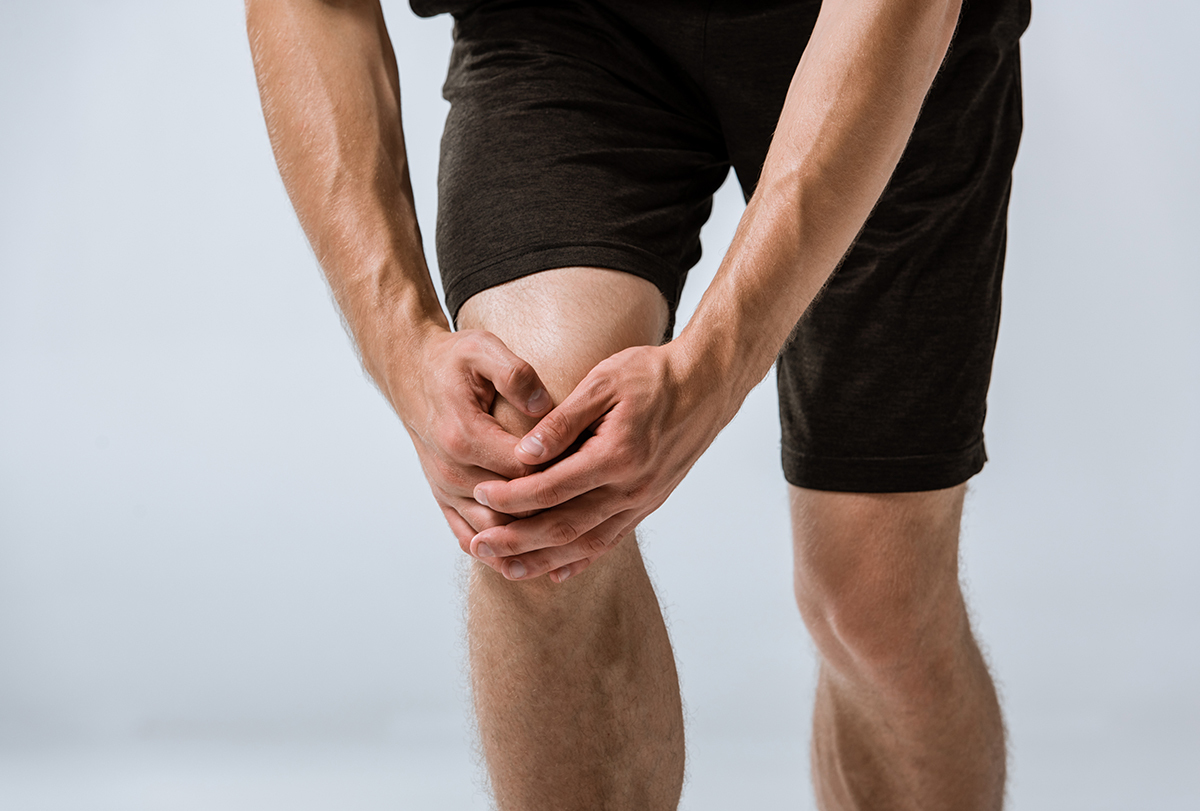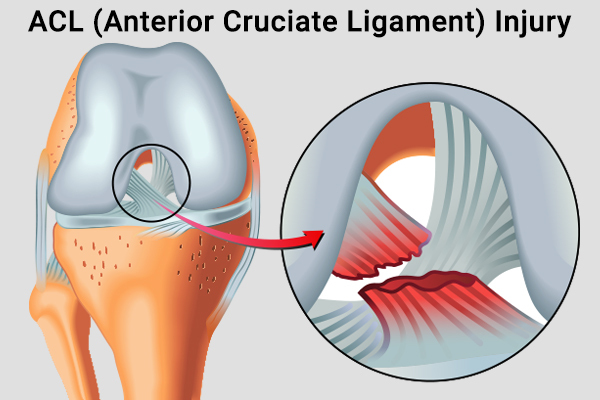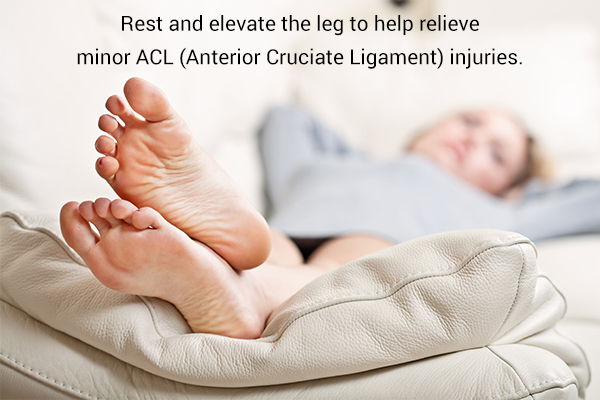In this article:
The knee is the largest joint in the body and contains four bones: the femur superiorly, the tibia and fibula inferiorly, and the patella anteriorly. (1)

Several ligaments connect the femur (the big thigh bone) to the smaller leg bones (tibia or fibula) and, in doing so stabilize the knee.
The anterior cruciate ligament (ACL) connects the back of the femur to the front of the tibia in a diagonal trajectory, thus protecting the tibia from forward laxity, instability, and aberrant movement. The ACL is the most crucial ligament for stabilizing the knee joint.
Is an ACL Injury a Serious One?
The ACL is frequently injured in athletes and those who sustain trauma and is, in fact, the most commonly injured knee ligament. The injury usually involves spraining or rupturing the ligament (either partially or fully) and is most common among football, soccer, and basketball players. (2)
The seriousness of this injury is based on the severity of the tear, comorbid injuries, and the patient’s overall health and age. It is important to seek medical consultation for any such injury, so that the doctor can properly assess the severity of the injury and prescribe the appropriate treatment. (3)
What Can Cause an ACL Tear?

An ACL injury/tear usually occurs as a result of running or jumping with a sudden change in direction or pivoting.
Another mechanism of ACL injury relates to a high-velocity impact or blow to the back of the leg (tibia), leading to the hyperextension of the joint and hyperstretching of the ligament. (4)
Similarly, a blow to the sides of the knee can provide enough stress to rupture the ACL. A number of extrinsic factors can affect a person’s risk for ACL tears, including footwear, sex (women are at higher risk), playing surface, and fatigue/deconditioning.
What Are the Symptoms of an ACL Tear?
Patients often complain of a “popping/snapping” feeling and/or sound at the time of rupture, followed by a few days of pain, swelling, and warmth. There may be a slight weakness with weight bearing immediately after the injury.
In the following weeks, patients may experience knee joint instability and a feeling that the knee might “give out” on them. This instability will be more pronounced with activities such as squatting, pivoting, turning, walking down the stairs, or stepping on uneven ground. (5)
How Long Does It Take to Recover From an ACL Injury?
Young athletes with an ACL tear are typically recommended surgery that involves taking their healthy tissue or donor ligaments to make a graft and using it to reconstruct the damaged ligament.
However, the new tissue can take as long as 9–10 months to become a part of the body and start forming a new ligament. (6) But in some exceptional cases, the patient may recover in as soon as 6 months.
The recovery time after ACL reconstruction surgery can vary from person to person, depending on their overall health, age, activity level, physiotherapy, and general care.
An average athlete usually takes a minimum of 8–9 months to make a full recovery. But the patient’s doctor and physiotherapist must sign off before they can go back to competitive sport.
According to research, nearly one-third of recovered athletes end up getting another ACL tear in the same or the other knee within two years of surgery. Thus, the more time you give for your ACL to heal properly (10 months or longer), the lesser chance of getting it re-injured. (7)
Can an ACL Injury Heal on Its Own?
Minor ACL tears/injuries, such as a low-grade partial tear, may heal on their own, provided that the patient does not play competitively or gets re-injured.
However, most ACL injuries cannot heal naturally since there is no blood supply to this ligament. In such cases, the players must undergo surgery to safely perform the sharp movements that their sport demands. (8)
ACL injuries are very slow to heal without active treatment. Treatment is tailored to the patient’s characteristics, such as age, health, activity levels, symptom severity, and the severity of the tear itself. Higher-grade partial tears or full tears require surgical interventions.
Despite conservative therapy, the ACL may require 3–6 months to heal and 6–12 months to return to its baseline level of stability. The recovery is longer and carries the potential complications if the patient does not seek physiotherapy and rehabilitation. (9)
What Is the Nonsurgical Treatment for ACL Injuries?

Some minor ACL injuries can be treated with the following nonsurgical interventions:
- Resting and elevating the affected leg
- Applying an ice pack to the affected area to curb the swelling
- Getting a knee brace to stabilize the joint
- Seeking physiotherapy to regain strength and full range of motion in the affected leg
- Taking anti-inflammatory drugs to reduce the knee inflammation
Bear in mind that these nonsurgical treatments of an ACL tear lead to slow and gradual healing only if you follow them diligently with limited activity levels. (10)
What Are the Consequences of Leaving an ACL Injury Untreated?
If left untreated, an ACL injury can lead to chronic knee joint instability, which predisposes the patient to further knee injuries such as meniscal tears, fracture, other ligament tears, and falls – not to mention chronic knee pain, inability to play sports competitively, decreased range of motion, and osteoarthritis.
Can a Patient Return to Sports After an ACL Surgery?
Yes, patients can return to their sport and baseline level of activity after a minimum of 9–12 months following an ACL repair surgery and only when there is no swelling, pain, or instability and once they have equal strength in both lower extremities and full range of motion.
Physiotherapy and rehab programs will work with patients to get them ready by that time frame, and such programs may be personalized to the individual.
Final Word
The best medicine is always prevention. Thus, an ACL injury can be avoided by regularly participating in lower body strength exercises (lunges, calf raises, Nordic hams), low- and high-intensity plyometric exercises, core exercises, and landing stabilization exercises. (11)
A number of prevention programs are available online. After a knee injury, the patient should always be assessed by a trained physician as a number of physical exams can be utilized to diagnose ACL tears. The physician will likely order an MRI to assess the severity of the injury and refer the patient to a sports medicine/ortho specialist.
- Was this article helpful?
- YES, THANKS!NOT REALLY


